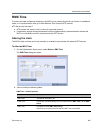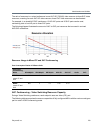
Administration and Utilities
Polycom®, Inc. 693
For more information about the Active Alarms, see Appendix B - Active Alarms.
2 Click one of the following buttons to view its report in the System Alerts pane:
Active Alarms Pane Columns
Field Description
ID
An identifying number assigned to the system alert.
Time
Lists the local date and time that the error occurred. This column also
includes the icon indicating the error level (as listed in the level column).
GMT Time
Lists the date and time according to Greenwich Mean Time (GMT) that
the error occurred.
Category Lists the type of error. The following categories may be listed:
• File indicates a problem in one of the files stored on the MCU’s hard disk.
•Card indicates problems with a card.
• Exception indicates software errors.
• General indicates a general error.
• Assert indicates internal software errors that are reported by the software
program.
•Startup indicates errors that occurred during system startup.
•Unit indicates problems with a unit.
•MPL indicates an error related to a Shelf Management component (MPL
component) other than an MPM, RTM or switch board (Collaboration Server
1500/2000/4000 only).
Level Indicates the severity of the problem, or the type of event. There are three fault
level indicators:
- Major Error
- System Message
- Startup Event
Code Indicates the problem, as indicated by the error category.
Process Name Lists the type of functional process involved.
Description When applicable, displays a more detailed explanation of the cause of the
problem.
System Alerts Buttons
Active Alarms (default) – this is the default reports list that is displayed when clicking the
System Alerts indication bar. It displays the current system errors and is a quick indicator of
the MCU status.
Faults Full List - A list of all system faults.
Note: Viewed when logged in as a special support user.


















